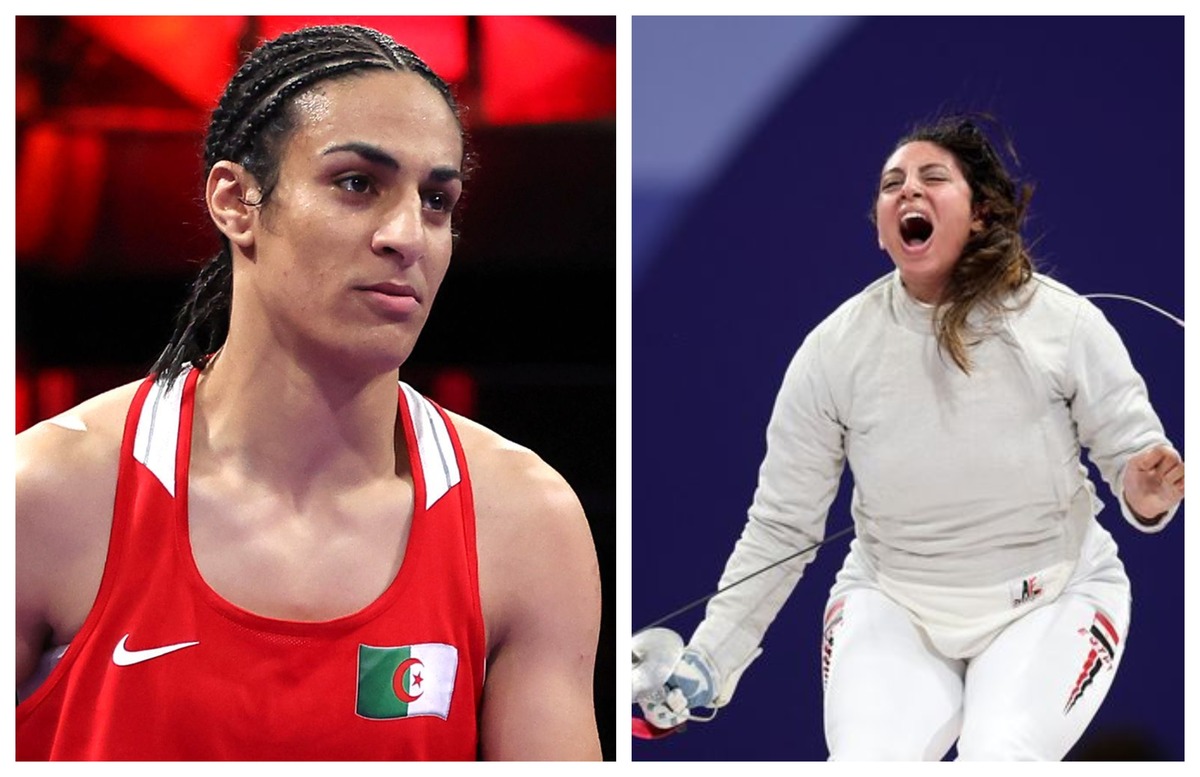Before we’ve even had a chance to fully grasp that the 2024 Paris Olympics have begun, follow the athletes, and learn about their achievements, one major topic has already dominated the world: women’s bodies.
In just one week, millions around the world are suddenly determining who qualifies as a woman athlete, what she is allowed to do, and how she should do it, all based on their own limited and narrow views of womanhood.
Two Egyptian athletes have recently become the focus of intense speculation and criticism, with their athletic abilities being questioned solely due to their reproductive status and bodily functions. Algerian boxer Imane Khelif has also faced online discrimination and bullying due to her body and physical attributes, with many individuals wrongly accusing her of being a man.
Egyptian fencer Nada Hafez recently went viral for competing while seven months pregnant, attracting a wave of criticism and backlash over her decision to continue competing during pregnancy. Similarly, Egyptian boxer Yomna Ayyad caused a stir by being disqualified from the 54 kg women’s event for not meeting the weight requirement.
The reactions and commentary have exposed a deeper societal issue: a wider ignorance about how women’s bodies function, as well as a tendency to use these bodies as a means to evaluate their talent, performance, and work ethic.
Rather than celebrating their athletic prowess, the focus has shifted to scrutinizing their personal biology, revealing a deeper issue of gender bias in the sports arena.
Policing women’s bodies
Policing the bodies of women athletes is a long-standing issue that continues to exist to this day. Historically, intense exercise was believed to jeopardize young women’s fertility, with misguided assumptions that women’s reproductive organs influences anatomy, physiology, and movement.
Studies once claimed that exercise could be detrimental to women’s health, but these claims were countered with equally strong arguments that physical activity during menstruation was not only safe but beneficial, and that athletic women could have healthy pregnancies.
Historian Martha Verbrugge, an expert on women’s health and bodies, argues that skepticism about female exercise extends beyond health concerns. She contends that these doubts are more deeply rooted in cultural attitudes than in biomedical research.
Despite the scientific research supporting women athletes, the central issue remains: why is a woman’s body the subject of global debate to the extent that it undermines her ability to perform and be recognized as a serious athlete?
Women’s bodies have long been associated with their external performance, and instead of fostering greater understanding and education about women’s health, this connection often leads to discussions shaped more by cultural attitudes and societal roles than by legitimate scientific inquiry.
The focus shifts away from their athletic achievements to questioning their eligibility as women to fulfill these roles in society. This broader discussion uses their bodies as a means to restrict and undermine women’s ambitions, turning their societal roles into a contentious issue.
Nada Hafez, who competed in the Olympics while seven months pregnant, faced significant backlash from Egyptians and even TV anchors. Critics have labeled her decision as irresponsible and have even suggested that her coach should face legal repercussions.
However, the backlash against Nada Hafez is more deeply rooted in cultural attitudes and biases toward pregnant women than in genuine medical concerns, as Verbrugge notes. Despite the increasing presence of Egyptian women in the workforce, their bodies and pregnancies are often viewed as disruptive to professional roles, reinforcing the notion that the ideal worker is male.
As one viral post states, “working from home while pregnant is considered acceptable, as is picking worms from fields of long-staple Egyptian cotton or cleaning stairs and washing carpets. However, traveling to the Olympics and competing in the round of 16 while pregnant is unacceptable.”
The post highlights the double standards in how pregnant women are treated, with their domestic work being seen as more acceptable than their professional activities or public roles. The notion that pregnant women should prioritize domestic labor over professional work is unfounded and discriminatory, as pregnancy does not alter a woman’s capacity to excel in any occupation.
In response to the backlash, Hafez explained that she had consulted her doctor, Professor Omar Abdel Aziz, to ensure that her participation in the Olympics was medically safe.
Hafez is not the first athlete to compete while pregnant. The Olympic Charter and the International Olympic Committee (IOC) rules do not explicitly ban pregnant athletes from participating in the Games. Decisions about their participation are based on medical assessments and doctors’ recommendations, considering both the athlete’s health and the safety of the fetus.
Throughout sports history, there have been several notable instances of athletes competing in championships while pregnant. One prominent example is Kerri Walsh Jennings, the renowned American beach volleyball player, who competed in the 2012 Summer Olympics in London while five months pregnant.
US tennis player Serena Williams also secured her record-breaking 23rd Grand Slam singles title at the Australian Open while eight weeks pregnant.
While there is still more work to be done to ensure full inclusion in the Olympics, particularly concerning physiological changes like postpartum depression and menstruation, the Games have made notable strides. For the first time, they have introduced a nursery for parent-athletes, complete with private breastfeeding areas, allowing them to spend time with their young children.
For Yomna Ayyad, the Egyptian boxer who faced bullying and criticism for not meeting the weight requirements at the Olympics, the issue extends beyond using women’s bodies as a pretext to restrict their performance. It also reflects a broader failure to recognize and acknowledge the impact of their bodily and hormonal changes.
A medical report attributed Ayyad’s weight gain to ‘physiological and hormonal changes’ as the reason for her disqualification, omitting any mention of her menstrual cycle. Viral posts later revealed that it was her menstrual cycle and criticized the Egyptian Olympic Committee for its lack of transparency about women’s health.
This lack of transparency about women’s bodily changes perpetuates a culture of secrecy and fuels ignorance regarding how these factors impact female athletes.
Omaima Idris, a professor of Obstetrics and Gynecology at Cairo University, addressed local media regarding the situation of boxing champion Yomna Ayyad. She explained that Ayyad’s symptoms are related to natural water retention associated with the menstrual cycle.
Idris also highlighted that research shows approximately 60 percent of women and girls experience temporary weight gain of between 500 grams to a kilogram during their menstrual period.
Her situation reveals a critical gap in women’s sports: a lack of proactive support for their mental, physical, and overall health. To prevent crises, we must go beyond participation rates and medal tallies to provide comprehensive care.
Gender controversy
Another woman making headlines for her body and physique is Algerian boxer Imane Khelif, who has faced unfounded attacks on her gender despite identifying as a woman since birth.
Her case highlights the discrimination faced by women with hormonal conditions like polycystic ovary syndrome (PCOS), which can impact both their appearance and athletic performance. As Moroccan feminist and activist Benslimane stated, “even with gender parity in participation at the Olympics this year, sports often remain influenced by patriarchal standards.”
Khelif has previously shared her experiences growing up in a rural village where her father initially forbade her from participating in sports, stating he did not approve of boxing for girls.
In a press conference, Mark Adams, spokesman for the International Olympic Committee, defended Khelif’s participation, stating, “I think the question you have to ask yourself is, are these athletes women? The answer is yes according to eligibility, according to passports, according to their history.”
Questioning women’s strength and performance in the Olympics is far from new. Renowned American gymnast and gold medalist Simone Biles has faced criticism for her muscular arms, while Serena Williams has long contended with conspiracy theories suggesting she was born a man.
In 2024, we are still confining women to narrow, stereotypical roles and deny their identities based on uncontrollable physical changes. Even as we continue to achieve strides in gender equality, the simple freedom to define one’s own womanhood remains a denied privilege.
The experiences of these women have laid bare not only societal attitudes towards women but also the cultural impact of sports. Sports is no longer just for entertainment, it is a direct reflection of our culture.
Women athletes have become a central part of our discussions, and the way we treat them reflects our broader treatment of women in society.







Comments (0)